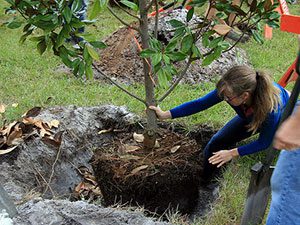Spring is the time of year that many people get enthusiastic about planting trees and shrubs in their landscape. While planting can be done during any season, fluctuations in temperature, rainfall, and other environmental conditions could influence establishment. Planting under hot, sunny, dry conditions—typical of the spring or fall in Florida—may reduce vigor and slow establishment unless regular irrigation is provided.
These ten steps for successful planting may seem simple, but many are often overlooked, resulting in poor plant health, possible decline or even death, and loss of time and money when the plants are replaced. Proper planting techniques help assure that establishment is quick, which helps conserve water and other resources.
- Call underground utility companies before you dig deep holes.

- Break up compacted soil.
- There is no benefit to amending backfill. If planting in a bed, add amendments to the entire planting area.
- Locate the point in the container (called the flare) where the first main root meets the trunk.
- Remove roots and media above the first main root.
- Dig the planting hole wide and shallow.
- Place the rootball in the ground and check that the first main root (flare) is just above the soil line.
- Back fill around the rootball.
- Mulch around the outside of the rootball; no mulch should be on the rootball.
- Water at planting and then on a regular schedule until the shrub is established.
Planting trees and shrubs too deep can eventually kill them because roots are deprived of oxygen. The above-ground symptoms include yellowing foliage, lack of growth, thinning of the canopy, and a general slow decline. No soil should be placed on top of the rootball. Excessive mulch can also cause a plant’s roots to be too deep. Pull back and/or remove excess mulch from the base of the plant. Another way to prevent deep planting is to dig the hole no deeper than the root ball. When the soil is loosened up under the root ball, the plant can settle after planting.
Replanting at the correct depth may allow the plant to recover if the problem is caught early but planting it right the first time is best!
More information on planting can be found here.
 0
0

